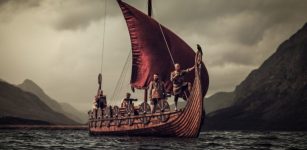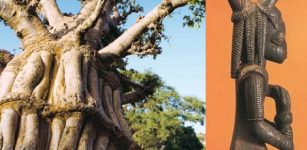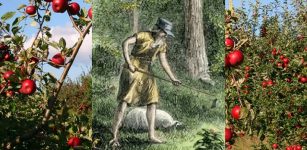Ancient Secrets Of The Damascus Steel – Legendary Metal Used By Crusaders And Other Warriors
Ellen Lloyd - AncientPages.com - When the Crusaders reached the Middle East in the 11th century, they discovered swords made of a metal that could slice a hair in half in mid-air, and yet it was strong enough to strike fear into even the bravest and most persistent warrior.
A shamshir (Persian/Iranian sword with a radical curve. The Royal Armoury, Stockholm, Sweden. Unknown author - LSH 77113 - Public Domain
Knowledge of the legendary metal spread, and it became known to the Europeans as the Damascus steel, named after the capital of Syria. Sometime in the 18th century, the formula for Damascus steel was lost, and the original method for producing Damascus steel remains an ancient secret.
Through the ages, armorers who made swords, shields, and armor were rigidly secretive regarding their method, and the formula of the Damascus steel was only known to a few persons.
Many modern attempts have been made to reproduce the metal, but no one has succeeded due to differences in raw materials and manufacturing techniques.
Damascus Steel And Its Remarkable Characteristics
From around the fourth century A.D., Damascus steel was manufactured in several regional locations. The swords produced with Damascus steel were extraordinary because the blades remained devastatingly sharp through battle after battle.
The Damascus steel gave rise to many legends, such as the ability to cut through a rifle barrel or to cut a hair falling across the blade. According to Dr. Helmut Nickel, curator of the Arms and Armor Division of the Metropolitan Museum of Art in New York, legend had it that the best blades were quenched in "dragon blood."
The swords were easily recognized by a characteristic watery or" damask" pattern on their blades." Damascus steel was not only a remarkable feat of engineering but also a thing of aesthetic beauty.
The metal was derived from Wootz, a type of steel originating in India unusually rich in carbon.
Based on archaeological evidence, it has been determined that the production fit the steel started in present-day Tamil Nadu before the start of the Common Era.
 Watered pattern on iranian sword blade. Close-up of an 18th-century Persian-forged Damascus steel sword. Image credit: Rahil Alipour Ata Abadi - GFDL
Watered pattern on iranian sword blade. Close-up of an 18th-century Persian-forged Damascus steel sword. Image credit: Rahil Alipour Ata Abadi - GFDL
The Arabs introduced the Indian wootz steel to Damascus, where a weapons industry thrived. Wootz steel was highly prized across several regions of the world over nearly two millennia, and one typical product made of this Indian steel came to be known as the Damascus swords.
From the 3rd century to the 17th century, India was shipping steel ingots to the Middle East.
Lost Knowledge Of The Damascus Steel Formula
By 1750, the production of Damascus swords gradually declined, and the process was lost to metalsmiths.
Why the swords were no longer produced is still a mystery. It has been suggested that Damascus steel production declined because firearms replaced blades, and there was less demand for metal. Another option is that the knowledge of the Damascus steel formula was only known to a small group and thus lost with time. Swordmakers succeeded in concealing their techniques from competitors and posterity.
It is also possible that the trade routes supplying Wootz from India were disrupted or that raw material supplies no longer had the same essential characteristics.
Modern Attempts To Re-Create Damascus Steel
A significant problem in scientific experiments on Wootz Damascus steel is the inability to obtain samples for study. Such a study requires that the blades be cut into sections for microscopic examination, and small quantities must be sacrificed for destructive chemical analysis.
A sword maker of Damascus, Syria. Image source
When researchers at the Technical University of Dresden used X-rays and electron microscopy to examine Damascus steel, they discovered the presence of cementite nanowires and carbon nanotubes. The study showed that these nanostructures are a result of the forging process.
Jeffrey Wadsworth and Oleg D. Sherby, two metallurgists at Stanford University, may have unraveled the mystery of the Damascus steel. According to Dr. Wadsworth, as suspected by several early metallurgists, an essential requirement is a very high carbon content.
Dr. Wadsworth and Dr. Sherby believe it has to be from 1 to 2 percent, compared to only a fraction of 1 percent in ordinary steel. Another critical element in Damascus blade production is forging and hammering at relatively low temperatures - about 1,700 degrees Fahrenheit. After shaping, the blades were reheated to about the same temperature, then rapidly cooled, as by quenching in a fluid.
"Modern Damascus" is made from several types of steel and iron slices welded together to form a billet, and currently, the term "Damascus" (although technically incorrect) is widely accepted to describe modern pattern-welded steel blades in the trade. The patterns vary depending on how the smith works the billet. The billet is drawn out and folded until the desired number of layers is formed. To attain a Master Smith rating with the American Bladesmith Society, it is necessary to forge a Damascus blade with a minimum of 300 layers.
Recreating Damascus steel is a subfield of experimental archaeology. Many have attempted to discover or reverse-engineer the process by which it was made, and several researchers have come a long way, but to completely reproduce the process has so far not been possible.
Damascus steel is, without doubt, magnificent art and cutting-edge technology that may be lost to humankind forever.
Written by Ellen Lloyd – AncientPages.com
Updated on Aug 13, 2023
Copyright © AncientPages.com All rights reserved. This material may not be published, broadcast, rewritten or redistributed in whole or part without the express written permission of AncientPages.com
Expand for referencesReferences:
Wes Sander, Intermediate Guide to Bladesmithing
More From Ancient Pages
-
 Flying Objects Were Present In Ancient Skies
Ancient Mysteries | May 9, 2014
Flying Objects Were Present In Ancient Skies
Ancient Mysteries | May 9, 2014 -
 What Can Ancient Toilets Teach Us About Maya Life And Tamales?
Archaeology | Jun 9, 2022
What Can Ancient Toilets Teach Us About Maya Life And Tamales?
Archaeology | Jun 9, 2022 -
 Mysterious Greyfriars Kirkyard: A Cemetery In Edinburgh With Dark And Spooky History
Featured Stories | Sep 16, 2016
Mysterious Greyfriars Kirkyard: A Cemetery In Edinburgh With Dark And Spooky History
Featured Stories | Sep 16, 2016 -
 Magical Ring Of Gyges And Its Power To Be Invisible At Will
Featured Stories | Feb 16, 2023
Magical Ring Of Gyges And Its Power To Be Invisible At Will
Featured Stories | Feb 16, 2023 -
 Will Archaeologists Uncover The Secrets Of A Rare Viking Ship Grave In Norway Before It’s Destroyed?
Archaeology | Nov 14, 2020
Will Archaeologists Uncover The Secrets Of A Rare Viking Ship Grave In Norway Before It’s Destroyed?
Archaeology | Nov 14, 2020 -
 Mysterious History Of Qin Shi Huang – First Emperor Of China
Featured Stories | Jan 17, 2016
Mysterious History Of Qin Shi Huang – First Emperor Of China
Featured Stories | Jan 17, 2016 -
 Aboriginal ‘Memories’ Of Australia’s Coastline Go Back More Than 7,000 Years
Civilizations | Sep 30, 2015
Aboriginal ‘Memories’ Of Australia’s Coastline Go Back More Than 7,000 Years
Civilizations | Sep 30, 2015 -
 Late Pleistocene Human Colonization – What Makes Our Species Unique Compared To Other Hominins?
Archaeology | Apr 29, 2020
Late Pleistocene Human Colonization – What Makes Our Species Unique Compared To Other Hominins?
Archaeology | Apr 29, 2020 -
 New Discoveries Regarding Gladiatorial Games In Roman City Of Carnuntum
Archaeology | Apr 7, 2017
New Discoveries Regarding Gladiatorial Games In Roman City Of Carnuntum
Archaeology | Apr 7, 2017 -
 Were Neanderthals Really As Well Adapted To A Life In The Cold As Previously Assumed? New Study
Archaeology | Apr 26, 2022
Were Neanderthals Really As Well Adapted To A Life In The Cold As Previously Assumed? New Study
Archaeology | Apr 26, 2022 -
 On This Day In History: Tokugawa Shogunate Begins In Japan After Historical Battle – On Oct 21, 1600
News | Oct 21, 2016
On This Day In History: Tokugawa Shogunate Begins In Japan After Historical Battle – On Oct 21, 1600
News | Oct 21, 2016 -
 Eshu The Trickster: Mischievous Mediator Between Heaven And Earth In Beliefs Of Yoruba People
African Mythology | Apr 4, 2019
Eshu The Trickster: Mischievous Mediator Between Heaven And Earth In Beliefs Of Yoruba People
African Mythology | Apr 4, 2019 -
 Legendary Johnny Appleseed Who Planted Apple Trees Across North America
Featured Stories | May 8, 2019
Legendary Johnny Appleseed Who Planted Apple Trees Across North America
Featured Stories | May 8, 2019 -
 God Dagda – A Powerful Leader Of The Tuatha De Danann In Celtic Mythology
Celtic Mythology | May 30, 2020
God Dagda – A Powerful Leader Of The Tuatha De Danann In Celtic Mythology
Celtic Mythology | May 30, 2020 -
 Well-Preserved Fragments Of Epetion’s Wall Discovered At The Hellenistic Site Of Stobreč, Near Split, Croatia
Archaeology | Oct 11, 2024
Well-Preserved Fragments Of Epetion’s Wall Discovered At The Hellenistic Site Of Stobreč, Near Split, Croatia
Archaeology | Oct 11, 2024 -
 Could Vancouver Island’s Hepburn Stone Be 15,000 Years Old?
Artifacts | Feb 20, 2021
Could Vancouver Island’s Hepburn Stone Be 15,000 Years Old?
Artifacts | Feb 20, 2021 -
 The Sistine Chapel Cypher – Secret Messages In The Art Of Michelangelo
Ancient Mysteries | Mar 3, 2018
The Sistine Chapel Cypher – Secret Messages In The Art Of Michelangelo
Ancient Mysteries | Mar 3, 2018 -
 Ancient Aqueduct System Discovered In Boroujerd, Lorestan
News | Sep 16, 2015
Ancient Aqueduct System Discovered In Boroujerd, Lorestan
News | Sep 16, 2015 -
 Incredibly Rare Iron Age Wooden Objects Discovered In 2,000-Year-Old Waterlogged Site In The UK
Archaeology | Jan 21, 2023
Incredibly Rare Iron Age Wooden Objects Discovered In 2,000-Year-Old Waterlogged Site In The UK
Archaeology | Jan 21, 2023 -
 Spearhead Mound – Destroyed Burial Place Of Adena Giants?
Featured Stories | Jun 1, 2021
Spearhead Mound – Destroyed Burial Place Of Adena Giants?
Featured Stories | Jun 1, 2021


